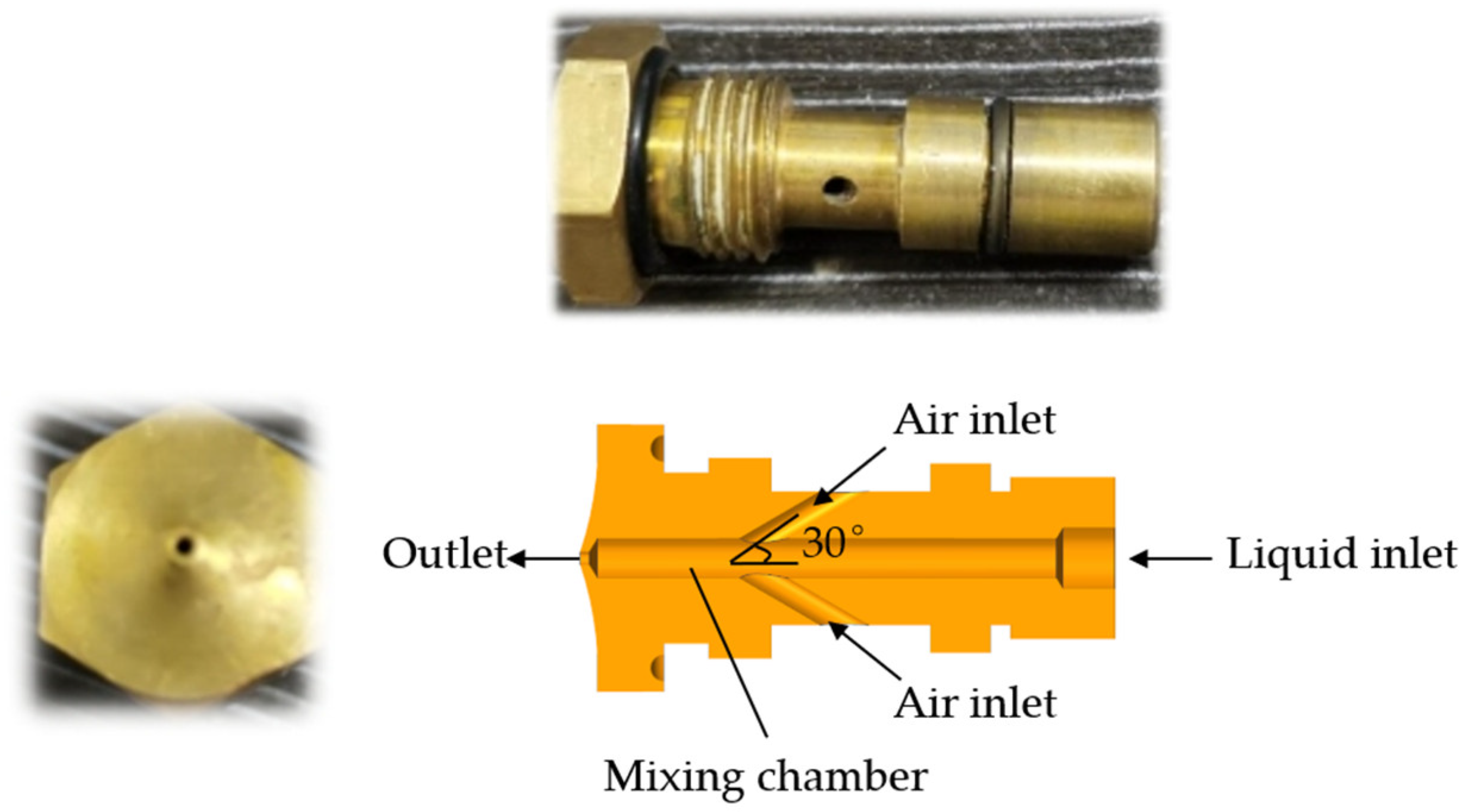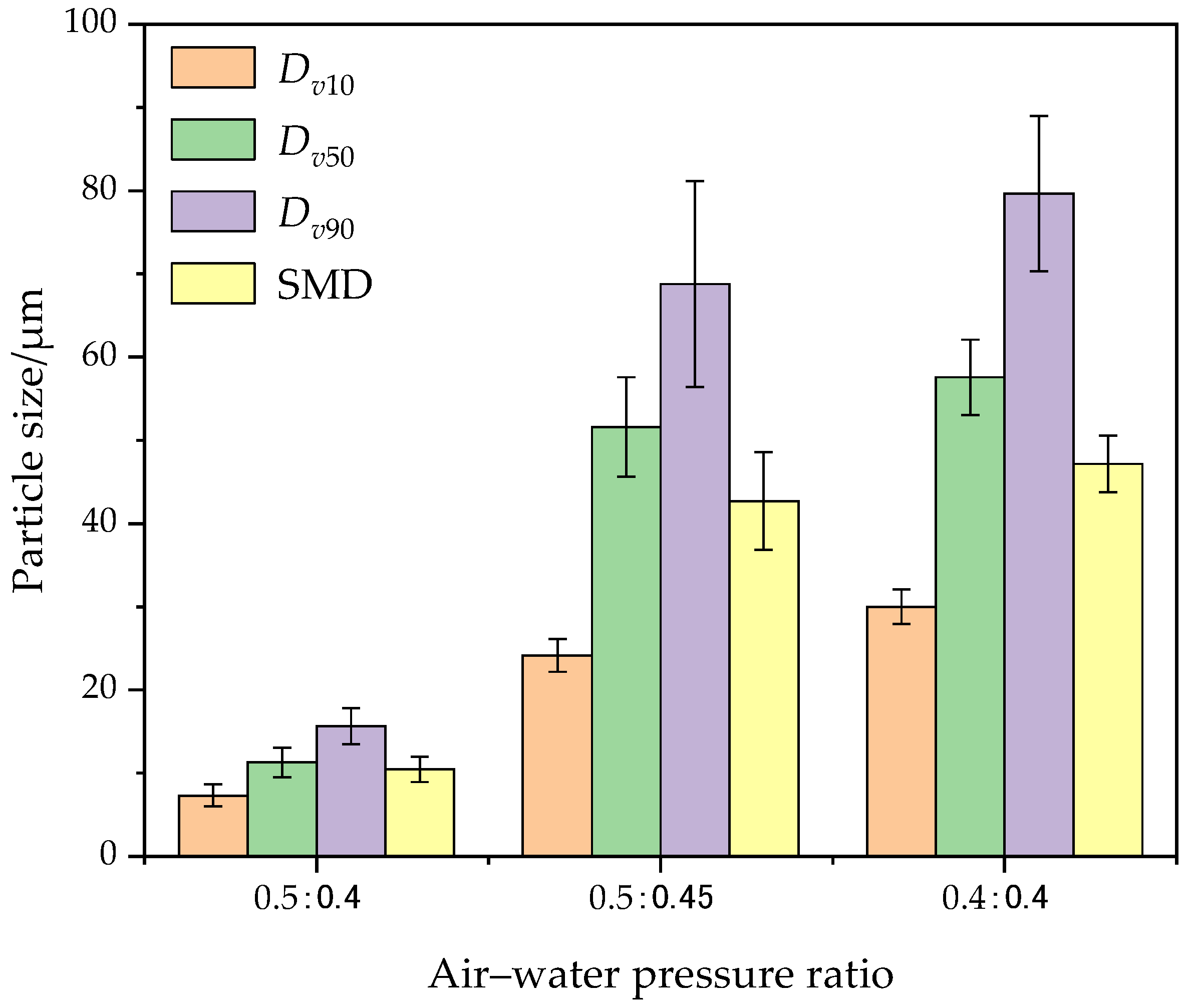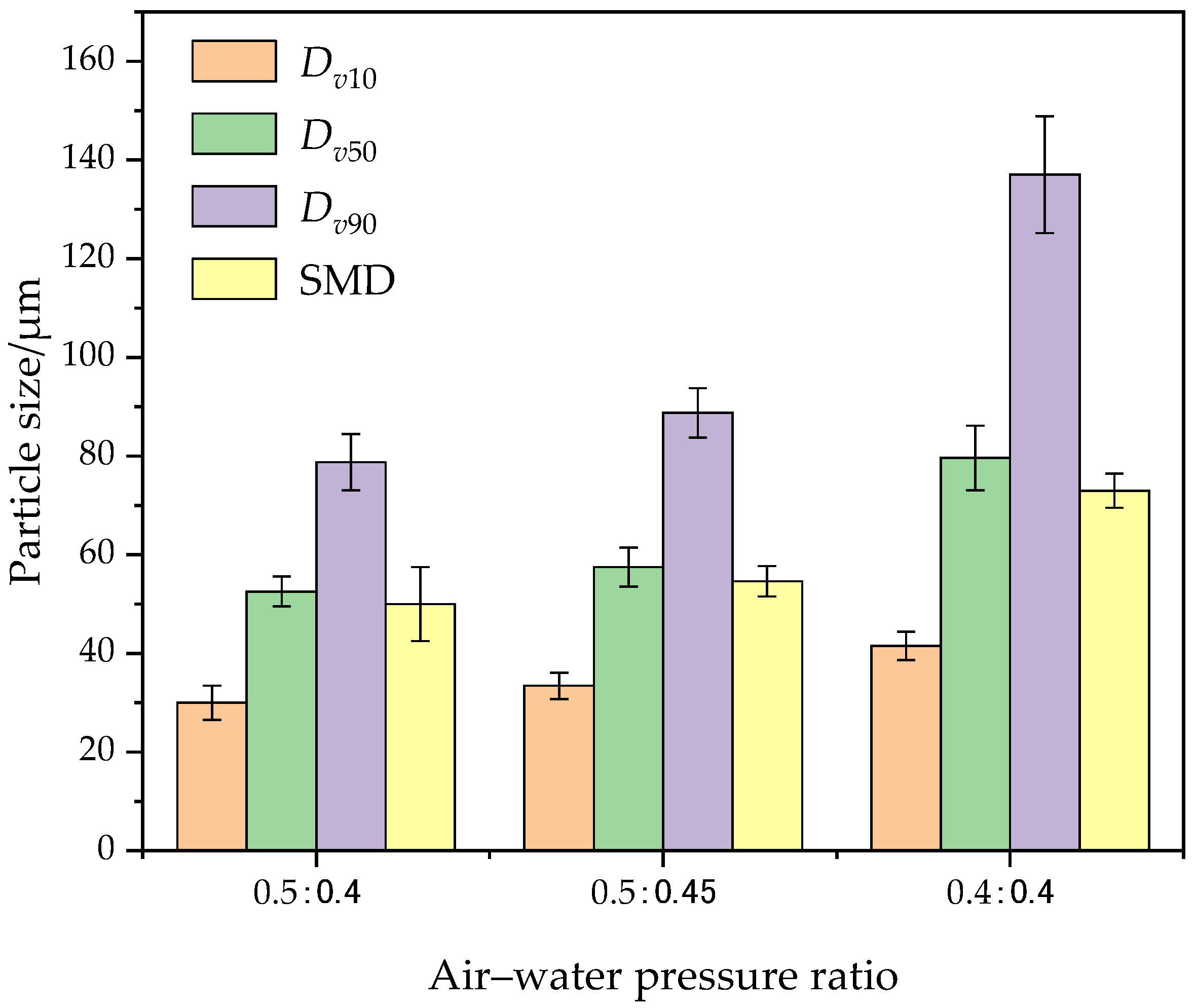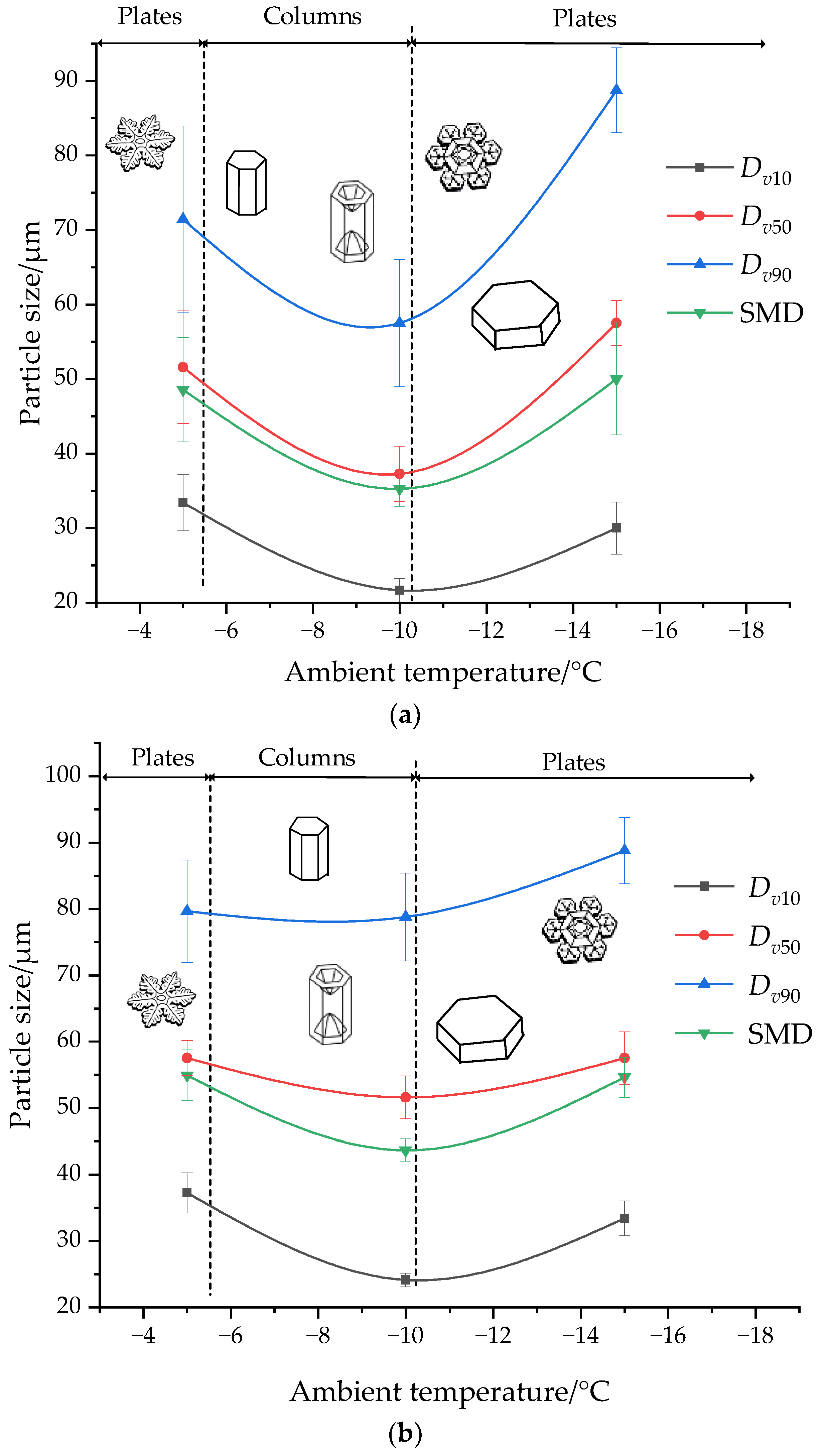An Experimental Investigation on the Size Distribution of Snow Particles during Artificial Snow Making
Abstract
:1. Introduction
2. Experimental Methodology
2.1. Experimental Setup
2.1.1. Artificial Snow-Making System
2.1.2. Atomizing Nozzle
2.2. Snow Particle Size Measurement System
2.3. Calculation Method of the Snow Particle Size
2.4. Experimental Equipment and Operating Conditions
3. Results and Discussion
3.1. Effects of Snowfall Height
3.2. Effects of Air–Water Pressure Ratio
3.3. Effects of Ambient Temperature
4. Conclusions
- (1)
- The snow particle size distribution is close to the R-R distribution. When the air–water pressure ratio and ambient temperature remain constant, within the range of 120 cm of snowfall height, as the snowfall height increases, snow crystals continue to grow, and the particle size of snow crystals gradually increases with the increase in the snowfall height. Therefore, in outdoor snow-makers, the growth status of snow crystals varies at different snowfall heights. It is particularly important for external mixed snow-makers.
- (2)
- When the snowfall height and ambient temperature are constant, air pressure can effectively improve the atomization effect. On the contrary, water pressure is unfavorable for atomization. The air–water pressure ratio increases from 0.4 MPa:0.4 MPa to 0.5 MPa:0.4 MPa, the two-phase flow velocity increases, the atomizing effect of the atomizing nozzle increases, and the snow particle size decreases. In outdoor snow-making applications, it is recommended to choose a higher air–water pressure ratio according to the necessary snow production to enhance atomization.
- (3)
- When the snowfall height and air–water pressure ratio are constant, the ambient temperature decreases from −5 °C to −15 °C, and the particle size of snow crystals first decreases and then increases. The snow crystal particle size reaches its minimum at around −10 °C. This is because the growth rates of snow crystals on the base crystal surface and prism crystal surface are different, resulting in the shape of snow crystals being plates at −5 °C or above, columns at −5 °C to −10 °C, and returning to plates at −10 °C to −15 °C. Compared with columnar snow crystals, plates snow crystals have a larger area, and the snowflake particle size formed when snow crystals grow outward is also larger.
Author Contributions
Funding
Data Availability Statement
Conflicts of Interest
References
- Deng, J.; Che, T.; Hu, Y.-X.; Yue, S.-N.; Pan, J.-H.; Dai, L.-Y. Climate Change Risk Assessment for Ski Areas in China. Adv. Clim. Change Res. 2023, 14, 300–312. [Google Scholar] [CrossRef]
- Steiger, R.; Posch, E.; Tappeiner, G.; Walde, J. The Impact of Climate Change on Demand of Ski Tourism—A Simulation Study Based on Stated Preferences. Ecol. Econ. 2020, 170, 106589. [Google Scholar] [CrossRef]
- Elsasser, H.; Bürki, R. Climate Change as a Threat to Tourism in the Alps. Clim. Res. 2002, 20, 253–257. [Google Scholar] [CrossRef]
- Damm, A.; Greuell, W.; Landgren, O.; Prettenthaler, F. Impacts of +2 °C Global Warming on Winter Tourism Demand in Europe. Clim. Serv. 2017, 7, 31–46. [Google Scholar] [CrossRef]
- Wang, R.; Zhang, B.; Xu, R.; Xing, M.; Zhang, H.; Zhang, H.; Yan, G.; Wu, H. Sensitivity of Atomization Characteristic to Operation Conditions for Air-Assisted Atomizers in Snow-Makers. Int. J. Refrig. 2023, 149, 146–154. [Google Scholar] [CrossRef]
- Hanzer, F.; Marke, T.; Strasser, U. Distributed, Explicit Modeling of Technical Snow Production for a Ski Area in the Schladming Region (Austrian Alps). Cold Reg. Sci. Technol. 2014, 108, 113–124. [Google Scholar] [CrossRef]
- Dong, P.; Chen, Q.; Liu, G.; Zhang, B.; Yan, G.; Wang, R. Effects of Geometric Parameters on Flow and Atomization Characteristics of Swirl Nozzles for Artificial Snowmaking. Int. J. Refrig. 2023, 154, 56–65. [Google Scholar] [CrossRef]
- Kang, Z.; Wang, Z.-G.; Li, Q.; Cheng, P. Review on Pressure Swirl Injector in Liquid Rocket Engine. Acta Astronaut. 2018, 145, 174–198. [Google Scholar] [CrossRef]
- Vijay, G.A.; Moorthi, N.S.V.; Manivannan, A. Internal and External Flow Characteristics of Swirl Atomizers: A Review. At. Sprays 2015, 25, 153–188. [Google Scholar] [CrossRef]
- Ma, R.; Dong, B.; Yu, Z.; Zhang, T.; Wang, Y.; Li, W. An Experimental Study on the Spray Characteristics of the Air-Blast Atomizer. Appl. Therm. Eng. 2015, 88, 149–156. [Google Scholar] [CrossRef]
- Guo, L.-J.; Li, G.-J.; Chen, B.; Chen, X.-J.; Papailiou, D.D.; Panidis, T. Study on Gas-Liquid Two-Phase Spraying Characteristics of Nozzles for the Humidification of Smoke. Exp. Therm. Fluid Sci. 2002, 26, 715–722. [Google Scholar] [CrossRef]
- Zhao, F.; Liu, Q.; Zhao, C.; Bo, H. Influence Region Theory of the Evaporating Droplet. Int. J. Heat Mass Transf. 2019, 129, 827–841. [Google Scholar] [CrossRef]
- Satyawali, P.K.; Singh, A.K.; Dewali, S.K.; Kumar, P.; Kumar, V. Time Dependence of Snow Microstructure and Associated Effective Thermal Conductivity. Ann. Glaciol. 2008, 49, 43–50. [Google Scholar] [CrossRef]
- Cogné, C.; Nguyen, P.U.; Lanoisellé, J.L.; Van Hecke, E.; Clausse, D. Modeling Heat and Mass Transfer during Vacuum Freezing of Puree Droplet. Int. J. Refrig. 2013, 36, 1319–1326. [Google Scholar] [CrossRef]
- Mirabedin, S.M.; Farhadi, F. Enquête Numérique Portant Sur La Solidification de Gouttelettes Uniques Avec et sans Mécanisme d’évaporation. Int. J. Refrig. 2017, 73, 219–225. [Google Scholar] [CrossRef]
- Liu, B.; Hu, H.; Bi, L.; Theodorakis, P.E. Analysis of the Characteristics of the Gas–Liquid Mixed Artificial Snow-Making. Int. J. Refrig. 2023, 149, 155–167. [Google Scholar] [CrossRef]
- Zhang, B.; Wang, R.; Wu, H.; Dong, P.; Xu, R.; Xing, M.; Zhang, H.; Cui, Z.; Yan, G.; Zhang, H. Atomization Characteristics of Twin Nozzles for Outdoor Snow-Makers Application. Int. J. Refrig. 2022, 139, 60–69. [Google Scholar] [CrossRef]
- Liu, C.; Liu, F.; Yang, J.; Mu, Y.; Hu, C.; Xu, G. Experimental Investigations of Spray Generated by a Pressure Swirl Atomizer. J. Energy Inst. 2019, 92, 210–221. [Google Scholar] [CrossRef]
- Li, Y.; Ning, Z.; Lü, M. Experimental Study on Fusion and Break-up Motion after Droplet Collision. Chin. J. Chem. Eng. 2020, 28, 712–720. [Google Scholar] [CrossRef]
- Han, J.; Liu, X.; Jiang, M.; Wang, Z.; Xu, M. An Improved On-Line Measurement Method of Particulate Matter Concentration Using Tri-Wavelength Laser Light Scattering. Fuel 2021, 302, 121197. [Google Scholar] [CrossRef]
- Huang, Y.; Liu, X.; Wang, Z.; Jiang, M.; Zhou, Z.; Xu, M.; Han, J.; Yang, B.; Fan, X. On-Line Measurement of Ultralow Mass Concentration Particulate Based on Light Scattering Coupled with Beta Ray Attenuation Method. Fuel 2022, 329, 125461. [Google Scholar] [CrossRef]
- Jin, Z.; Charlock, T.P.; Yang, P.; Xie, Y.; Miller, W. Snow Optical Properties for Different Particle Shapes with Application to Snow Grain Size Retrieval and MODIS/CERES Radiance Comparison over Antarctica. Remote Sens. Environ. 2008, 112, 3563–3581. [Google Scholar] [CrossRef]
- Rashad, M.; Yong, H.; Zekun, Z. Effect of Geometric Parameters on Spray Characteristics of Pressure Swirl Atomizers. Int. J. Hydrogen Energy 2016, 41, 15790–15799. [Google Scholar] [CrossRef]
- Dafsari, R.A.; Vashahi, F.; Lee, J. Effect of Swirl Chamber Length on the Atomization Characteristics of a Pressure-Swirl Nozzle. At. Sprays 2017, 27, 859–874. [Google Scholar] [CrossRef]
- Nguyen, D.; Duke, D.; Kastengren, A.; Matusik, K.; Swantek, A.; Powell, C.F.; Honnery, D. Spray Flow Structure from Twin-Hole Diesel Injector Nozzles. Exp. Therm. Fluid Sci. 2017, 86, 235–247. [Google Scholar] [CrossRef]
- Gordon, M.; Taylor, P.A. Measurements of Blowing Snow, Part I: Particle Shape, Size Distribution, Velocity, and Number Flux at Churchill, Manitoba, Canada. Cold Reg. Sci. Technol. 2009, 55, 63–74. [Google Scholar] [CrossRef]
- Chen, L.; Li, G.; Ma, X.; Lim, J.; Sivathanu, Y. A Method for Measuring Planar Sauter Mean Diameter of Multi-Component Fuel Spray Based on the Combined Statistical Extinction Tomography and Particle Imaging Velocimetry. Fuel 2018, 214, 154–164. [Google Scholar] [CrossRef]
- Ma, W.; Li, F.; Zhou, X. An Empirical Model of Snowdrift Based on Field Measurements: Profiles of the Snow Particle Size and Mass Flux. Cold Reg. Sci. Technol. 2021, 189, 103312. [Google Scholar] [CrossRef]
- Kumar, R.; Gopireddy, S.R.; Jana, A.K.; Patel, C.M. Study of the Discharge Behavior of Rosin-Rammler Particle-Size Distributions from Hopper by Discrete Element Method: A Systematic Analysis of Mass Flow Rate, Segregation and Velocity Profiles. Powder Technol. 2020, 360, 818–834. [Google Scholar] [CrossRef]
- Chouippe, A.; Krayer, M.; Uhlmann, M.; Dušek, J.; Kiselev, A.; Leisner, T. Heat and water vapor transfer in the wake of a falling ice sphere and its implication for secondary ice formation in clouds. New J. Phys. 2019, 21, 043043. [Google Scholar] [CrossRef]
- Libbrecht, K.G. Morphogenesis on Ice: The Physics of Snow Crystals. Eng. Sci. 2001, 64, 10–19. [Google Scholar]
- Libbrecht, K.G. The physics of snow crystals. Rep. Prog. Phys. 2005, 68, 855–895. [Google Scholar] [CrossRef]
















| Equipment | Parameters | Uncertainty |
|---|---|---|
| Thermostatic Water Container | Volume: 0.35 m3 Temperature range: 4~10 °C | \ |
| Pump | Rated power: 4 kW Pressure range: 0.3~1.0 MPa | \ |
| Air Compressor | Rated power: 4 kW Rated speed: 750 r/min | \ |
| Surge Tank | Volume: 0.6 m3 Pressure range: 0.2~0.8 MPa | \ |
| Pressure Transducer | Measuring range: 0~0.8 MPa | ±0.1% |
| Flowmeter | Max measuring range: 1 L/min | ±3% |
| Split Laser Particle Sizer | Measuring range: 5~200 µm | ±5% |
| Parameters | Value |
|---|---|
| Water temperature (°C) | 4 |
| Snow height (cm) | 25~120 |
| Air–water pressure ratio | 0.5 MPa:0.4 MPa, 0.5 MPa:0.45 MPa, 0.4 MPa:0.4 MPa |
| Ambient temperature (°C) | −15~−5 |
| Air–Water Pressure Ratio | Flow Velocity (m/s) | Reynolds Number |
|---|---|---|
| 0.5 MPa:0.4 MPa | 690.1 | 38,339 |
| 0.5 MPa:0.45 MPa | 550.3 | 30,572 |
| 0.4 MPa:0.4 MPa | 524.2 | 29,122 |
Disclaimer/Publisher’s Note: The statements, opinions and data contained in all publications are solely those of the individual author(s) and contributor(s) and not of MDPI and/or the editor(s). MDPI and/or the editor(s) disclaim responsibility for any injury to people or property resulting from any ideas, methods, instructions or products referred to in the content. |
© 2023 by the authors. Licensee MDPI, Basel, Switzerland. This article is an open access article distributed under the terms and conditions of the Creative Commons Attribution (CC BY) license (https://creativecommons.org/licenses/by/4.0/).
Share and Cite
Zhao, W.; Li, Z.; Zhang, H.; Su, M.; Liu, Z.; Chen, P.; Han, Y. An Experimental Investigation on the Size Distribution of Snow Particles during Artificial Snow Making. Energies 2023, 16, 7276. https://doi.org/10.3390/en16217276
Zhao W, Li Z, Zhang H, Su M, Liu Z, Chen P, Han Y. An Experimental Investigation on the Size Distribution of Snow Particles during Artificial Snow Making. Energies. 2023; 16(21):7276. https://doi.org/10.3390/en16217276
Chicago/Turabian StyleZhao, Wei, Zheng Li, Hua Zhang, Mingxu Su, Zhenzhen Liu, Pengju Chen, and Yaqian Han. 2023. "An Experimental Investigation on the Size Distribution of Snow Particles during Artificial Snow Making" Energies 16, no. 21: 7276. https://doi.org/10.3390/en16217276





